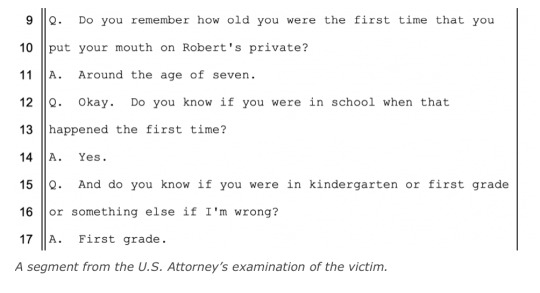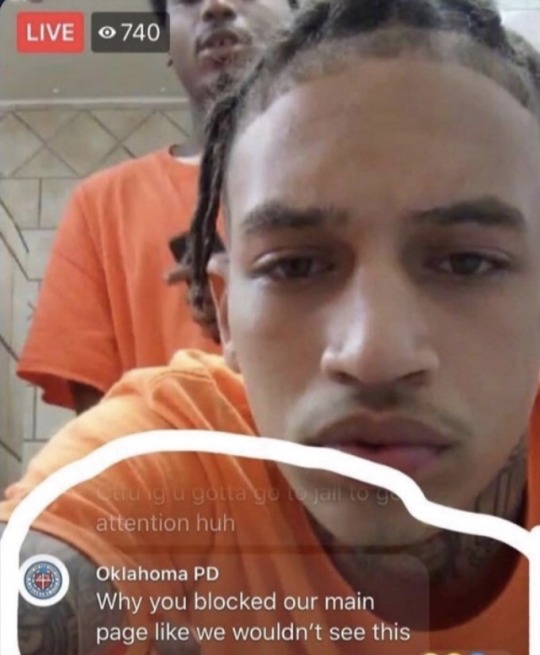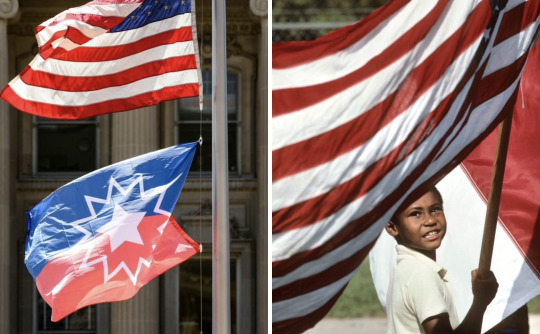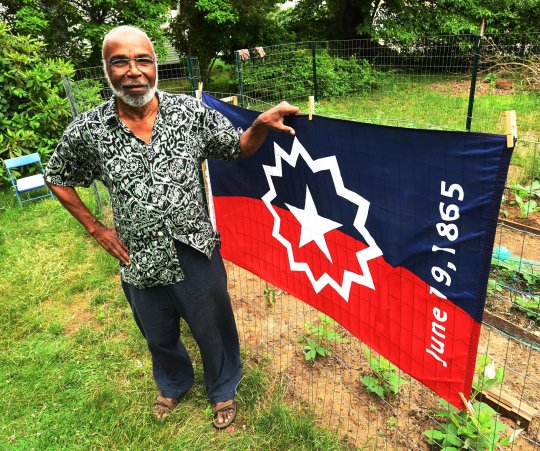#oklahoma prison
Text

October 15 1966
Black Panther Party Of Self Defense
Oakland, California
#black panther party of self defense#blaxploitation#melanin#black family#youtube#2pac shakur#marcus garvey#afeni shakur#assata shakur#ed poindexter#kathleen cleaver#elridge cleaver#sundiata acoli#rosa parks#black wall street#tulsa oklahoma#tulsa 1921#mutulu shakur#victims of white supremacy#free the political prisoners#free the black community#free breakfast program
5 notes
·
View notes
Text
youtube
Curtis Montrell Williams: Took a prison guard hostage and got his brain turned into Kool-Aid as a reward!
Warning: Lots of awesome violence!
3 notes
·
View notes
Text
Another male sex offender who started claiming to be a woman when he was found quilts and facing prison time
Content Warning: This article contains graphic descriptions of child sexual abuse as reported in court testimony. Reader discretion is appreciated.
A convicted pedophile appears to have declared a transgender identity while being sentenced for the horrific sexual abuse of a young girl.
On February 23, Robert William Perry II was sentenced to life in federal prison following a conviction for the aggravated sexual abuse of a minor. The victim, a 7-year-old girl for whom Perry was responsible, was abused over the course of one year while in Perry’s care.
According to the U.S. Department of Justice, Perry would coerce the girl into performing sex acts in exchange for candy, toys, and the opportunity to play video games in what Perry termed as a “man cave,” a closet where he regularly played video games and watched pornography. The abuses took place from 2017 to 2018 on the Muscogee Nation reserve in Tulsa, Oklahoma.
The child eventually divulged some of the details of her ordeal to a school friend, and the conversation was overheard by another student who immediately went to a teacher and reported what she had heard. The Oklahoma Department of Human Services was contacted, and the victim was interviewed by a Sexual Assault Nurse Examiner. The girl was hesitant to speak about what had happened because Perry had told her to “keep secrets,” but she would go on to draw pictures of what had happened to her.
Perry was initially arrested and charged in 2018 and he was convicted in an Oklahoma state court in 2020, but the conviction was later dismissed because the state lacked the jurisdiction to prosecute the case. In the United States, only the federal government or tribal councils have jurisdiction to prosecute cases that occur in Indian Country that involve Native American defendants. Because Perry is Indigenous and the crime had been committed on Muscogee land, the case was turned over to the federal government.
During a hearing in May of 2022, his victim testified in federal court as to what had happened to her.
Reduxx has reviewed a transcription of the child’s testimony and is withholding identifying details out of respect for her privacy.
While in court, the girl explained that Perry had a closet where he played video games and smoked. Perry would take her into the closet when there was no one else in the home.
The child detailed that Perry would tell her to strip naked and kneel on the floor, and she would be instructed to take his genitals into her mouth. The girl, who was 11 when she gave her testimony, said Perry would force his penis into her throat and it cause her to choke, among other abuses which included Perry touching and licking her genitals. After sexually abusing the girl, Perry would give her Jolly Ranchers or Starburst. The abuses happened regularly after school.

Perry was found guilty on counts of aggravated sexual abuse of a minor in Indian Country and for abusive sexual contact of a minor in Indian Country.
Perry was sentenced in February of 2023, and, shortly after, the U.S. Department of Justice amended their press release, noting that Perry now went by “she/her” pronouns. Previous releases had described Perry as a “man.”
Court documents reveal that Perry’s change in gender identity appears to have been declared around the same time he was being sentenced to life in prison for his crimes. A sentencing outcome signed by the judge in the case requested Perry be sent to a medium security facility in the Tulsa area with explicit provisions for “gender-care treatment programs.”
Other than the sentencing document, Perry’s gender identity was never mentioned during the trial.

Perry has been placed under the jurisdiction of the Bureau of Prisons due to the fact his crimes were committed on the Muscogee Nation reservation. Under current Bureau of Prisons guidelines, Perry would be able to request housing on the basis of his self-declared gender identity.
On January 13 of 2022, the Bureau of Prisons revised its Transgender Offender Manual, which included guidelines previously scrubbed by the Trump administration with respect to gender self-identification for federal inmates. Under Trump, inmates were housed based on biological sex as a sole consideration, but the Biden administration re-invoked Obama-era guidelines requiring gender identity be considered when making housing assignments.
There are currently 1,500 federal inmates who identify as transgender. According to Keep Prisons Single Sex USA, almost 50% of trans-identified male federal inmates are in custody for sex offences. This is compared to just 11% of the non-trans male federal inmate population.
#USA#oklahoma#Robert William Perry II#Trans identified male sex offender#Keep Prisons Single Sex Act
6 notes
·
View notes
Photo

Le cuirassé USS Oklahoma (BB-37) devant la prison d'Alcatraz dans la baie de San Francisco – Californie – 1930's
©Naval History and Heritage Command - NH 84546-KN
#Avant-guerre#Pre-war#Marine américaine#US Navy#USN#Marine militaire#Military navy#Navire de guerre#Warship#Cuirassé#Battleship#Classe Nevada#Nevada-class battleship#USS Oklahoma#BB-37#Prison d'Alcatraz#Alcatraz jail#Baie de San Francisco#San Fransisco Bay#Californie#California#Etats-Unis#United States of America#USA#1930's
5 notes
·
View notes
Text

#meme#not my meme#not mine#photo dump#meme dump#prison#police#Oklahoma PD#facebook#facebook love#dank#dank meme
2 notes
·
View notes
Text
6.3.22 Headlines
WORLD NEWS
Ukraine: Russia may be in Ukraine to stay after 100 days of war (AP)
“When Vladimir Putin sent troops into Ukraine in late February, the Russian president vowed his forces would not occupy the country. But as the invasion reached its 100th day Friday, Moscow seemed increasingly unlikely to relinquish the territory it has taken in the war.”
Germany: At least 4 killed in Bavaria train crash (BBC)
“At least four people were killed and about 30 injured when a train derailed in Germany's south-eastern state of Bavaria, police say. The train, which was carrying many students, was heading to Munich when three carriages came off the tracks near Garmisch-Partenkirchen. It is unclear what caused the accident, a police spokesperson said.”
Pakistan: Taliban militants announce indefinite ceasefire with Islamabad (BBC)
“The Pakistani Taliban has announced an indefinite ceasefire with Pakistan's government after talks brokered by the Afghan Taliban government. The Pakistani Taliban (TTP) said substantial progress had been made at the talks in Kabul, and the truce extended until further notice. A Pakistani government official said the talks were moving in a positive direction, AFP news agency reports. The TTP has been fighting Pakistan's armed forces for years.”
US NEWS
Hospital Shooting: Tulsa shooting highlights vulnerability of hospitals (AP)
“The vulnerability of health care facilities was highlighted by a shooter who killed four people and then himself Wednesday at a hospital in Tulsa, Oklahoma. The assailant got inside a building on the Saint Francis Hospital campus with little trouble, just hours after buying an AR-style rifle, authorities said.”
Church Shooting: Man fatally shot 2 women, self in Iowa church lot (AP)
“Authorities planned to release more details Friday about a shooting outside an Iowa church in which a man fatally shot two women before apparently killing himself. The shooting happened just before 7 p.m. Thursday in the parking lot of the Cornerstone Church, a megachurch on the outskirts of Ames. Sheriff’s Capt. Nicholas Lennie declined early Friday to give the ages and names of those killed, but confirmed that they were adults.”
Prison Escape: Police fatally shoot Texas escapee who killed 5 while on run (AP)
“A convicted murderer on the run since escaping a prison bus after stabbing its driver last month was fatally shot by law enforcement after he killed a family of five and stole a truck from a rural weekend cabin, a Texas prison system spokesman said. Gonzalo Lopez, 46, died in a shootout with police late Thursday in Jourdanton, about 35 miles (55 kilometers) south of San Antonio, after driving the pickup more than 200 miles (322 kilometers) from the cabin, said Jason Clark, spokesman for the Texas Department of Criminal Justice.”
#current events#news#ukraine#russia#war#germany#bavaria#pakistan#taliban#islamabad#united states#hospital shooting#tulsa shooting#church shooting#gun violence#crime#prison escape#texas#iowa#oklahoma
4 notes
·
View notes
Text
0 notes
Text




Oklahoma DOC Intake Mugshot
Inmate wearing an orange intake jumpsuit photographed before and after his head shave.
53 notes
·
View notes
Photo

“Surrenders,” Border Cities Star. October 18, 1932. Page 19.
----
W. KIRBY ROBINSON
Sixty-five years old. of Cabazon, Calif, a fugitive from justice for 31 years, surrendered at the Leavenworth Federal Penitentiary October 12, to serve a four-year sentence for post office robbery which he evaded by leaping from a moving train in Indian territory, now Oklahoma. Robinson was married twice and served a term as deputy sheriff at Westmoreland. Calif. He said he surrendered to clear his conscience.
#cabazon#escaped convict#leavenworth penitentiary#federal bureau of prisons#wanted fugitive#sentenced to the penitentiary#oklahoma#the great depression#history of crime and punishment#turning yourself in
0 notes
Photo

In #Oklahoma, 25 #deathrow #inmates have been placed in an #execution queue that extends from August 2022 through Christmas 2024 “including multiple #prisoners with severe #mentalillness, #braindamage, and claims of #innocence." “This rush to execute would be reckless in any state, but Oklahoma in particular has a horrendous track record for problematic executions," said Krisanne Vaillancourt Murphy, the executive director of @cmnendthedeathpenalty an anti-death-penalty #advocacy group affiliated with the @usccb The teaching of the #Church on the #deathpenalty is in “clear alignment with the #Gospel and also in alignment with the Universal Declaration of #HumanRights,” protecting “the inalienable right to life of every human being and the inviolable #dignity of the human person made in the image of #God, who can never under any circumstances, be rendered completely senseless and deliberately killed.” -@helenprejean Brett Farley of Oklahoma #conservativesconcernedaboutthedeathpenalty added that "the principal question in the matter” also remains to be heard out: “Are we really a state and a #culture that values #life?” Learn more at @americamedia @thejesuitpost @beajesuit @jesuitswest @jesuitsglobal @franciscus @deathpenaltyaction #justice #socialjustice #prison #prisonindustrialcomplex #peopleoverprofit #peopleoverprofits #death #deathpenalty #sanctity #sanctityoflife #catechism #stopexecutions #conservative (at Portland, Oregon) https://www.instagram.com/p/CiAzcAyriYJ/?igshid=NGJjMDIxMWI=
#oklahoma#deathrow#inmates#execution#prisoners#mentalillness#braindamage#innocence#advocacy#church#deathpenalty#gospel#humanrights#dignity#god#conservativesconcernedaboutthedeathpenalty#culture#life#justice#socialjustice#prison#prisonindustrialcomplex#peopleoverprofit#peopleoverprofits#death#sanctity#sanctityoflife#catechism#stopexecutions#conservative
0 notes
Text
Enough is enough
“A nation is not conquered until the hearts of its women are on the ground. Then it is done, no matter how brave its warriors or how strong their weapons.”(Cheyenne proverb)
We’re experiencing a pivotal moment where Oklahoma can say “enough is enough” and allow women to protect themselves, even in complicated situations. Let me explain.
For the last decade, I’ve been at the University of Oklahoma, and while my journey may be unique, it has always followed the evidence.
My career began as a SWAT officer and police detective. I know firsthand the importance of the justice system and the need to hold people accountable for the commission of crime. The things I saw in those roles made me question why people commit crime and led me to a career in forensic psychopathology.
I moved to Oklahoma in 2013 to investigate differential criminal behavior among women. If you didn’t know, Oklahoma incarcerates women at rates among the highest in the developed world. We are three to five times higher than New York or California and over 15 times higher than Iran, a country currently in cultural and political upheaval regarding women’s rights.
Data shows men and women commit crimes with fundamentally different drives and motivations. While the majority of all criminal justice-involved people have experienced trauma, women who commit crimes have experienced trauma that’s significantly more extreme and problematic.
ACE (adverse childhood experience) scores measure childhood trauma on a scale of 1 to 10. The average ACE in the United States is about 1.5. The average in Oklahoma is about 3, and the average for an incarcerated woman in Oklahoma is over 5 with about 40% of incarcerated women in Oklahoma having an ACE score of 7 or higher.
Adding to the impact of this childhood trauma, upward of 65% of incarcerated women in Oklahoma were in abusive relationships at the time of their arrest. Trauma follows them across their life span and creates a biological injury to the brain that can cause mental illness, and almost always affects behavior and decision making.
However, did you know that evidence of abuse isn’t commonly considered by courts in most states when handing down sentences? In February, Rep. Toni Hasenbeck, R-Elgin, introduced legislation, House Bill 1639, that would help domestic violence survivors who fight back against the person abusing them.
When that legislation passed the Oklahoma House with a unanimous vote on March 22, it was a key step toward allowing the courts to have more discretion when sentencing crimes where domestic abuse plays a significant factor.
HB 1639 also could give women convicted of a crime the opportunity to provide evidence of their abuse for consideration at sentencing modification hearings.
We already know a majority of women in Oklahoma prisons are trauma survivors. Courts not taking into account the abuses these women have suffered is basically saying they’re OK with our criminal justice systems endorsing the abuse.
Rigid sentencing laws have already devastated too many women who have experienced terrible trauma. I think that’s why HB 1639 has had such strong support, so far.
I also strongly believe our state’s lawmakers should maintain the language demanded by impacted families. Our legal system must consider the circumstances behind every crime, and sentences should be proportional — and retroactive — depending on each individual situation.
The authors of HB 1639 didn’t say people should be free to commit crimes or avoid responsibility for their actions. Rather, they said context is important. They got the bill language — both the sentencing angles and the retroactivity — exactly right.
I encourage Oklahoma legislators to pass HB 1639 with full retroactivity, and to limit sentences to 10 years and allow courts to rehear cases and hand down shorter sentences to people who show a significant link between the domestic violence they experienced and their crime.
It’s the right thing to do. Because, truly, enough is enough
By David A. McLeod, Ph.D., MSW, is associate director and professor at the Anne and Henry Zarrow School of Social Work at the University of Oklahoma.
#Oklahoma#USA#women in prison#oklahoma incarcerates more women that Iran#ACE (adverse childhood experience)#Childhood trauma and incarceration later in life#Domestic abuse and Women’s self defense#HB 1639
3 notes
·
View notes
Text
#intersectionality#failure to protect#punishing the victim#institutional ignorance#child abuse#spousal abuse#black women matter#oklahoma#racism#sexism#bullshit#home-wrecking#prison reform
0 notes
Text
This April [2021], the Iowa Department of Corrections issued a ban on charities, family members, and other outside parties donating books to prisoners. Under the state’s new guidelines, incarcerated people can get books only from a handful of “approved vendors.” Used books are prohibited altogether [...].
In 2018, the Michigan prison system introduced an almost identical set of rules, and Ohio, Pennsylvania, and Washington have all made attempts to block book donations, which were only rolled back after public outcry. Across the United States, the agencies responsible for mass imprisonment are trying to severely limit incarcerated people’s access to the written word [...].
---
The official narrative is that donated books could contain “contraband [...]" -- the language used in Michigan [...]. This is a flimsy justification that begins to fall apart under even the lightest scrutiny. [...] [Contraband] [...] [is] not originating from nonprofit groups like the Appalachian Prison Book Project or Philadelphia’s Books Through Bars. [....] The old cartoon scenario of a hollow book with a saw or a gun inside just isn’t realistic, and its invocation is a sign that something else is going on.
That “something else,” predictably enough, is profit. With free books banned, prisoners are forced to rely on the small list of “approved vendors” chosen for them by the prison administration. These retailers directly benefit when states introduce restrictions. In Iowa, the approved sources include [B&N] and [B-a-M], some of America’s largest retail chains -- and, notably, ones which charge the full MSRP value for each book, quickly draining prisoners’ accounts. An incarcerated person with, say, $20 to spend can now only get one book, as opposed to three or four used ones; in states where prisoners make as little as 25 cents an hour for their labor, many can’t afford even that.
---
With e-books, the situation is even worse, as companies like [GTL] supply supposedly “free” tablets which actually charge their users by the minute to read.
Even public-domain classics, available on Project Gutenberg, are only available at a price under these systems -- and prisons, in turn, receive a 5% commission on every charge. All of this amounts to rampant price-gouging and profiteering on an industrial scale.
---
The rise of these private vendors has also been mirrored by the systematic dismantling of the prison library system. In the last ten years, budgets for literacy and educational resources have seen dramatic cuts, reducing funding to almost nothing [...]. In Illinois, for instance, the Department of Corrections spent just $276 on books across the entire state in 2017, down from an already meager $605 the previous year. (This means, incidentally, that each of the state’s roughly 39,000 prisoners was allotted seven-tenths of a cent.)
Oklahoma, meanwhile, has no dedicated budget for books at all, requiring prison librarians to purchase them out-of-pocket. [...]
---
These practices become all the more abhorrent when you consider the impact books can have behind bars. By now, the social science on their benefits is well-established [...]. [O]ther inmates have reported that reading meant “the difference between just giving up mentally and emotionally and making it through another day, week, or year,” countering the dehumanizing effects of their imprisonment. A book can offer a brief, irreplaceable moment of calm in hellish circumstances. [...]
[There is] a shameful pattern in American society, where many people simply don’t think about the incarcerated on a day-to-day basis, let alone sympathize with their worsening conditions. [...] One of the most common arguments for the American carceral system, and its continued existence, is that of rehabilitation. According to its defenders, a prison is not simply a place of suffering, where unwanted populations are sent to disappear. Nor is it a callous money-making machine, intended to squeeze free labor from them in a regime of functional slavery. Instead, prison rehabilitates -- so the story goes. [...] In these terms, the basic legitimacy of mass imprisonment, and its allegedly positive social role, is taken for granted. [...] But the practice of book banning exposes the lie. Not only do American prisons have little interest in education, healing, and growth, but they will actively prevent them the moment there is a dollar to be made or an ounce of power to be secured.
---
Text by: Alex Skopic. "The American Prison System's War on Reading". Protean (Protean magazine online). 29 November 2021. [Bold emphasis and some paragraph breaks/contractions added by me.]
1K notes
·
View notes
Photo






Juneteenth is a Black American holiday.
We call Juneteenth many things: Black Independence Day, Freedom Day, Emancipation Day, Jubilee Day. We celebrate and honor our ancestors.
December 31 is recognized as Watch Night or Freedom’s Eve in Black American churches because it marks the day our enslaved ancestors were awaiting news of their freedom going into 1863. On January 1, 1863, President Lincoln issued the Emancipation Proclamation. But all of the ancestors wouldn’t be freed until June 19, 1865 for those in Galveston, Texas and even January 23, 1866 for those in New Jersey (the last slave state). (It’s also worth noting that our people under the Choctaw and Chickasaw Nations wouldn’t be freed until April 28, 1866 and June 14, 1866 for those under the Cherokee Nation by way of the Treaties.)
Since 1866, Black Americans in Texas have been commemorating the emancipation of our people by way of reading the Emancipation Proclamation and coming together to have parades, free festivities, and later on pageants. Thereafter, it spread to select states as an annual day of commemoration of our people in our homeland.
Here’s a short silent video filmed during the 1925 Juneteenth celebration in Beaumont, Texas:
youtube
(It’s also worth noting that the Mascogos tribe in Coahuila, Mexico celebrate Juneteenth over there as well. Quick history lesson: A total of 305,326 Africans were shipped to the US to be enslaved alongside of American Indians who were already or would become enslaved as prisoners of war, as well as those who stayed behind refusing to leave and walk the Trail of Tears to Oklahoma. In the United States, you were either enslaved under the English territories, the Dutch, the French, the Spanish, or under the Nations of what would called the Five “Civilized” Native American Tribes: Cherokee, Creek (Muscogee), Chickasaw, Choctaw, and Seminoles. Mascogos descend from the Seminoles who escaped slavery during the Seminole Wars, or the Gullah Wars that lasted for more than 100 years if you will, and then settled at El Nacimiento in 1852.)
We largely wave our red, white and blue flags on Juneteenth. These are the only colors that represent Juneteenth. But sometimes you may see others wave our Black American Heritage flag (red, black, and gold).
Juneteenth is a day of respect. It has nothing to do with Africa, diversity, inclusion, immigration, your Pan-African flag, your cashapps, nor your commerce businesses. It is not a day of “what about” isms. It is not a day to tap into your inner colonizer and attempt to wipe out our existence. That is ethnocide and anti-Black American. If you can’t attend a Black American (centered) event that’s filled with education on the day, our music, our food and other centered activities because it’s not centered around yours…that is a you problem. Respect our day for what and whom it stands for in our homeland.
Juneteenth flag creator: “Boston Ben” Haith

It was created in 1997. The red, white and blue colors represent the American flag. The five-point star represents the Lone State (Texas). The white burst around the star represents a nova, the beginning of a new star. The new beginning for Black Americans.
Black American Heritage Flag creators: Melvin Charles & Gleason T. Jackson

It was created in 1967, our Civil Rights era. The color black represents the ethnic pride for who we are. Red represents the blood shed for freedom, equality, justice and human dignity. Gold fig wreath represents intellect, prosperity, and peace. The sword represents the strength and authority exhibited by a Black culture that made many contributions to the world in mathematics, art, medicine, and physical science, heralding the contributions that Black Americans would make in these and other fields.

SN: While we’re talking about flags, I should note that Grace Wisher, a 13-year-old free Black girl from Baltimore helped stitched the Star Spangled flag, which would inspire the national anthem during her six years of service to Mary Pickersgill. I ain’t even gon hold you. I never looked too far into it, but she prob sewed that whole American flag her damn self. They love lying about history here until you start unearthing them old documents.
In conclusion, Juneteenth is a Black American holiday. Respect us and our ancestors.
#juneteenth#juneteenth flag#black american history#black american culture#ben haith#black american heritage flag#melvin charles#gleason t jackson#grace wisher#american flag#mascogos#juneteenth 2023
1K notes
·
View notes
Text
Republicans introduce a 7th anti-furry bill and work to undermine student freedoms on a wider scale
(This blog post was written by Orion Scribner and N. Noel Sol, originally posted on February 18, 2024 to the Otherkin News Dreamwidth, at this link.)
Content warnings: Rated G. An urban legend that describes an unsanitary situation. Sexism against transgender people, including attempts to prevent them from participating in sports and using facilities like everyone else, and attempts to stop them from transitioning.
Summary: In 2023, Republicans began to propose laws (bills) in the US that would be against people who identify as animals. They base these on an urban legend that says schools provide litter boxes for students who identify as animals. Republicans made up that legend in parody of transgender students asking to use school restrooms (Scribner and Sol, 2024). The newest of these bills is Missouri House Bill 3678 (MO HB 2678). It’s the third such bill in 2024, bringing the historic total of these bills up to seven. This bill was written as part of a Republican effort to undermine public schools (which can’t ban transgender students from using the right restrooms, and students have First Amendment rights) in favor of religious charter schools (where students aren’t protected in those ways). The following blog post is a seven minute read.
What the Missouri bill says
Missouri House Bill 3678 (MO HB 2678) has the title “Prohibits students from engaging in ‘furry’ behavior while at school.” You can read this bill and see the latest actions on its official site, the Missouri House of Representatives, or on a third-party legislation tracking site, LegiScan. This bill was introduced this week, on February 13th, and read a second time on the 14th. It would add a law into the Revised Statutes of Missouri (RSMo). It would go in the part of the state laws about education, in Chapter 167, titled “Pupils and Special Services.” It would say:
“A student who purports to be an imaginary animal or animal species or who engages in anthropomorphic behavior consistent with the common designation of a ‘furry’ while at school shall not be allowed to participate in school curriculum or activities. The parent or guardian of a student in violation of this section shall remove the student from the school for the remainder of the school day.”
The same as the other bills like it, this bill is based on an urban legend, not on anything that was done in real life by students, furries, and/or people who identify as animals (McKinney, 2022a). This bill's wording looks like it was based on a bill from another state, Oklahoma House Bill 3084 (OK HB 3084), or its predecessor last year, Oklahoma Senate Bill 943 (OK SB 943). It shares their inaccuracies: though there are real people who identify as animals, surveys show that most furries don’t, and the dictionary definition of the word “anthropomorphic” means resembling a human, not resembling an animal (Scribner and Sol, 2024).
Who wrote the bill, and what is its context with that author’s other motivations?
The Missouri bill’s only sponsor (writer) is Cheri Toalson Reisch (she/her). She is a Missouri Republican who has supported anti-transgender bills in the past. One of those is MO SB 39, which would ban transgender students from participating in their gender’s sports division (both in private and public schools, up to and including in colleges and universities). Another one is MO SB 49. It would bar minors from accessing gender transition related surgeries or medications, removes adult coverage of hormone replacement therapy and any gender-affirming or transitioning surgeries from the Missouri Medicaid program, and denies prisoners and inmates access to any surgeries related to gender transitioning. She described both these bills as a “great move in the right direction,” and has been vocally critical that they were not harsher (Central MO Info, 2023).
Reisch is familiar with the urban legend started by conservatives of students using litter boxes in school bathrooms. She has posted about it on Facebook, telling her constituents that it is actively happening in Missouri and accusing the Columbia school district of taking part in it, stating “This is happening in Columbia Public Schools also. Yes, the janitor has to clean the litter box” (McKinney, 2022a). That's never happened. Schools say they have not been providing litter boxes to students in this way, and even deny that they have had any students identifying or behaving as animals, according to reliable fact checking resources (Reuters, 2022; Palma, Snopes, 2023).
Reisch has a history of being especially critical of the Columbia school district, which is one of the largest and most successful school districts in the state (McKinney, 2022b). She’s used this urban legend to attack the district’s legitimacy. This may be because Reisch prioritizes independently-run charter schools over standard public schools. Earlier this year, she sponsored MO HB 1941, which would allow for charter schools to operate within the Columbia school district without the district’s sponsorship.
Why are Republicans criticizing public schools and favoring charter schools?
In the US, the normal types of schools for children up to about age 18 are called public schools. Families don’t have to pay for their children to attend them. They represent the ideal that everyone growing up in the country should have equal access to school, regardless of income, class, race, religion, or ability. Because public schools are government establishments, the US Constitution protects the students’ rights there. The First Amendment of the Constitution protects the freedom of speech and religion of everyone, and that’s for students in public schools, too. In the landmark 1969 case Tinker v. Des Moines Independent Community School District, students sued because they had gotten suspended for wearing black armbands to protest the Vietnam War. The Supreme Court decided that it would be as tyrannical to prevent students from expressing political opinions within public schools as it would be in any other government establishments. The Court said students don’t “shed their constitutional rights to freedom of speech or expression at the schoolhouse gate.” In 1948, McCollum v. Board of Education had decided that public schools can’t give religious instruction during the school day. In 1962, Engel v. Vitale decided they can’t make students pray (Pew Research Center, 2019). Public school dress codes often aren’t as fair as they should be, but for the most part, their students can wear what they want and what their parents allow.
In contrast, what are known as charter schools in the US are privately owned, so they’re allowed to have requirements or education goals which would be considered a violation of the First Amendment. Some of them have religious affiliations and may be owned or operated by religious organizations. This can affect the way the school is run. For example, Oklahoma charter St. Isidore of Seville Catholic Virtual School has planned Catholic religious instruction classes, and the school’s active and intentional participation in what it refers to as “the evangelizing mission of the Church” (Fitzpatrick, 2023). Charter school dress codes can be much more strict. They are often segregated by gender stereotypes, forcing girls to wear skirts and boys trousers, no exceptions. This has been challenged in some places against specific schools, such as in North Carolina earlier this year in a lawsuit against the Charter Day School Inc (Chung, 2023). These challenges are the outlier and not the norm, however; gender-segregated dress codes are still a very common practice for charter schools overall. Charter schools also require applications and choose students based on random lottery systems. However, studies find that charter schools are more likely to ignore parents inquiring about the enrollment process if the student has a disability or other special needs (Darville, 2018). Unlike public schools, they don’t welcome everyone.
The freedom of expression in public schools is important for transgender students. In 2020, the case G.G. v. Gloucester County School Board decided in favor of transgender-friendly restroom policies in high schools. This precedent helps protect transgender students’ rights in public schools, but doesn’t apply to charter schools. During the course of the case, the Conservative Legal Defense and Education Fund told the Court why to decide against transgender rights. In an effort to invalidate transgender people, the Fund compared transgender people to otherkin. The Fund used the word “otherkin,” and described them at length, mostly accurately but derisively (Brief Amicus Curiae, 2017, G.G. v. Gloucester Cty Sch Bd). This case was part of what inspired the Republicans to later make up the litter box urban legend. We don’t know if that particular brief inspired the legend too.
Republicans may be promoting charter schools because this would give them greater control over impressing their views about gender, religion, and politics on young generations. They may be undermining public schools because the separation of church and state limits their power to do so there. The urban legend and these bills are part of that.
Background about all of the furry bills and the urban legend that inspired them
To learn about this year’s first two anti-furry bills, read our post about them from last week (Scribner and Sol, 2024). That post also summarizes the four anti-furry bills last year, and the litter box urban legend. For further information about those aspects, you can watch our lecture about last year’s bills and what you do about bad bills (Chimeras, Scribner, and Shepard, 2023), and watch Chimeras’s lecture about the litter box urban legend (Chimeras, 2022).
What happens next with Reisch’s anti-furry bill?
The bill is at 25% progression toward becoming a law. The House heard the bill twice, but it hasn’t been voted on. At the time that we write this blog post, they haven’t scheduled the bill’s next hearing.
About the writers of this blog post
We are Orion Scribner (they/them) and N. Noel Sol (she/they), a couple of dragons. We never write articles with the assistance of procedural generation or so-called artificial intelligence (AI), and that type of content isn’t allowed on Otherkin News.
References
“Brief Amicus Curiae of Public Advocate of the United States, U.S. Justice Foundation, and Conservative Legal Defense and Education Fund in Support of Petitioner.” Gloucester County School Bd. v. G. G. ex rel. Grimm, No. 16-273, 2017 WL 192454 (Jan. 10, 2017). http://files.eqcf.org/cases/16-273-amicus-brief-public-advocate-et-al/
Central MO Info (May 19, 2023). “Representative Toalson Reisch Disappointed in Senate’s Version of Trans Bills.” Central MO Info. https://www.centralmoinfo.com/representative-toalson-reisch-disappointed-in-senates-version-of-trans-bills/
Chung, Andrew (June 26, 2024). “US Supreme Court turns away case on charter school's mandatory skirts for girls.” Reuters. https://www.reuters.com/legal/us-supreme-court-turns-away-case-charter-schools-mandatory-skirts-girls-2023-06-26
Darville, Sarah (Dec. 21, 2018). “Want a charter school application? If your child has a disability, your questions more likely to be ignored, study finds.” Chalkbeat. https://www.chalkbeat.org/2018/12/21/21106398/want-a-charter-school-application-if-your-child-has-a-disability-your-questions-more-likely-to-be-ig/
Engel v. Vitale, 370 U.S. 421 (1962). https://caselaw.findlaw.com/court/us-supreme-court/370/421.html
Fitzpatrick, Cara (Sept. 9, 2023). “The Charter-School Movement’s New Divide.” The Atlantic. https://www.theatlantic.com/ideas/archive/2023/09/charter-schools-religion-public-secular/675293/
G.G. v. Gloucester County School Board. 972 F.3d 586 (4th Cir. 2020). https://casetext.com/case/grimm-v-gloucester-cnty-sch-bd-8
House of Chimeras (Aug. 12, 2022). "Litter Boxes in School Bathrooms: Dissecting the Alt-Right’s Current Moral Panic." OtherCon. https://youtu.be/WVjXOmN2IlU
House of Chimeras, Orion Scribner, and Page Shepard (2023). “Litter Box Hoax 2: Legislature Boogaloo.” OtherCon 2023. https://www.youtube.com/watch?v=lsXy_ctC4Jc&t=1425s
Legiscan. MO HB 2678. https://legiscan.com/MO/bill/HB2678/2024
Legiscan. MO HB 1941. https://legiscan.com/MO/bill/HB1941/2024
Mccollum v. Board Of Education, 333 U.S. 203 (1948). https://caselaw.findlaw.com/court/us-supreme-court/333/203.html
McKinney, Rodger (Aug. 25, 2022). “State Rep. Cheri Reisch criticized for 'unwarranted' claim that CPS students use litterboxes.” Columbia Daily Tribune. https://www.columbiatribune.com/story/news/politics/elections/local/2022/08/25/state-rep-cheri-reisch-criticized-for-unwarranted-claim-that-cps-columbia-students-use-litterboxes/7895082001/
McKinney, Rodger (Feb. 6, 2022). “State Rep. Cheri Reisch states 'Columbia sucks' when referring to public schools in education hearing” Columbia Daily Tribune. https://www.columbiatribune.com/story/news/education/2022/02/06/cheri-reisch-states-columbia-sucks-when-referring-to-cps-in-education-hearing-mo-leg-basye/6662719001/
Missouri House of Representatives. MO HB 2678. https://house.mo.gov/Bill.aspx?bill=HB2678&year=2024&code=R
Missouri Senate. MO SB 49. https://www.senate.mo.gov/23info/BTS_Web/Bill.aspx?SessionType=R&BillID=44407
Missouri Senate. MO SB 39. https://senate.mo.gov/23info/BTS_Web/Bill.aspx?SessionType=R&BillID=44496
Palma, Bethania. (January 30, 2023). “How Furries Got Swept Up in Anti-Trans 'Litter Box' Rumors.” Snopes. https://www.snopes.com/news/2023/01/30/how-furries-got-swept-up-in-anti-trans-litter-box-rumors/ Archived on March 30, 2023. https://web.archive.org/web/20230330232007/https://www.snopes.com/news/2023/01/30/how-furries-got-swept-up-in-anti-trans-litter-box-rumors/
Pew Research Center (Oct. 3, 2019). “Religion in the Public Schools.” https://www.pewresearch.org/religion/2019/10/03/religion-in-the-public-schools-2019-update/
Reuters Fact Check (October 18, 2022). “Fact Check-No evidence of schools accommodating ‘furries’ with litter boxes.” https://www.reuters.com/article/factcheck-furries-rogan-litterbox-idUSL1N31J1KT Archived February 13, 2023. https://web.archive.org/web/20230213110524/https://www.reuters.com/article/factcheck-furries-rogan-litterbox-idUSL1N31J1KT
Scribner, Orion, and N. Noel Sol (Feb. 9, 2024). “Will Oklahoma Call Animal Control on Students?” Otherkin News. https://otherkinnews.dreamwidth.org/92680.html
Tinker v. Des Moines Independent Community School District, 393 U.S. 503 (1969). https://openjurist.org/393/us/503
#furry#otherkin#nonhuman#alterhuman#OK HB 3084#urban legend#fact check#Missouri#long post#otherkin news#transphobia#rated G#MO HB 2678#screen reader friendly#unsanitary
194 notes
·
View notes